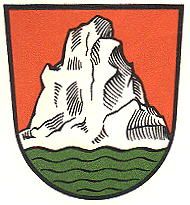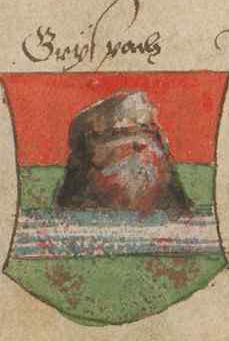The Coat of Arms of Alland, Lower Austria
I like the way that when you look somewhere up on Wikipedia you tend to get given its coat of arms and I've noticed over time that the heraldry for particular places and regions occasionally includes landscape features. Rivers are an obvious example. Wikimedia includes a whole category 'rivers in heraldry' which range from the subtle - just wavy lines or patches of blue - to complete symbolic landscapes like the one above, for the market town of Alland in Austria.
Although my father is a heraldry buff, I know little about it and so I will have to quote here from the International Heraldry site. They explain how landscape symbols ('charges') have been used over the years:
The oldest geological charge is the mount, typically a green hilltop rising from the lower edge of the field, providing a place for a beast, building or tree to stand. Natural mountains and boulders are not unknown, though ranges of mountains are differently shown. An example is the arms of Edinburgh, portraying Edinburgh Castle atop Castle Rock. Volcanos are shown, almost without exception, as erupting, and the eruption is generally stylised. In the 18th century, landscapes began to appear in armoury, often depicting the sites of battles. For example, Admiral Lord Nelson received a chief of augmentation containing a landscape alluding to the Battle of the Nile.
Lord Nelson's coat of arms - note the landscape above the shield.
If you take a particular European region and look at its heraldry you will mostly see lots of lions and eagles and crosses, but there will also be a few clues to the local topography. Taking a pretty much random example, consider the state of Rhineland-Palatinate in Germany, which has twenty-four districts. River symbols representing the Rhine appear on the arms of the districts of Ahrweiler, Germersheim and Rhein-Pfalz-Kreis. A wavy white line in the arms of Mayen-Koblenz represents both the Rhine and the Moselle. The district of Südliche Weinstraße is named after the tourist wine route and has a white bar representing the route and grapes representing the wine. As this shows, such designs are not ancient, although they can incorporate older motifs - the Rhein-Pfalz-Kreis shield includes water lilies which were used in earlier Rhineland heraldry. The best one from a landscape point of view is shown below. The jug represent the ceramic industry, the green band refers to forests and the basalt columns symbolise the Westerwald's volcanic rock.





No comments:
Post a Comment